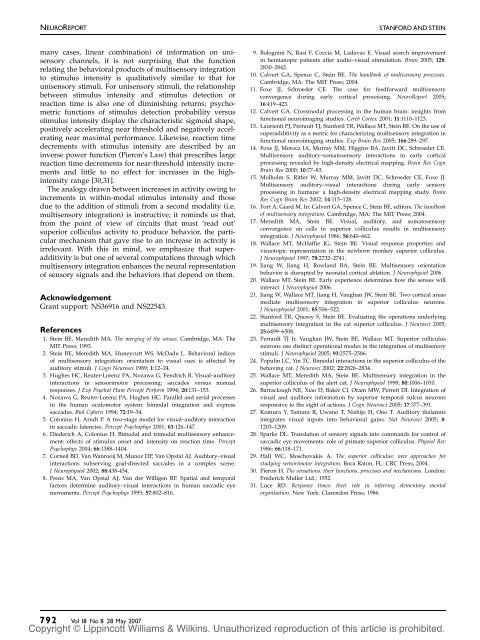Superadditivity in multisensory integration: putting the ... - CI Wiki
Superadditivity in multisensory integration: putting the ... - CI Wiki
Superadditivity in multisensory integration: putting the ... - CI Wiki
Create successful ePaper yourself
Turn your PDF publications into a flip-book with our unique Google optimized e-Paper software.
NEUROREPORT<br />
STANFORD AND STEIN<br />
many cases, l<strong>in</strong>ear comb<strong>in</strong>ation) of <strong>in</strong>formation on unisensory<br />
channels, it is not surpris<strong>in</strong>g that <strong>the</strong> function<br />
relat<strong>in</strong>g <strong>the</strong> behavioral products of <strong>multisensory</strong> <strong>in</strong>tegration<br />
to stimulus <strong>in</strong>tensity is qualitatively similar to that for<br />
unisensory stimuli. For unisensory stimuli, <strong>the</strong> relationship<br />
between stimulus <strong>in</strong>tensity and stimulus detection or<br />
reaction time is also one of dim<strong>in</strong>ish<strong>in</strong>g returns; psychometric<br />
functions of stimulus detection probability versus<br />
stimulus <strong>in</strong>tensity display <strong>the</strong> characteristic sigmoid shape,<br />
positively accelerat<strong>in</strong>g near threshold and negatively accelerat<strong>in</strong>g<br />
near maximal performance. Likewise, reaction time<br />
decrements with stimulus <strong>in</strong>tensity are described by an<br />
<strong>in</strong>verse power function (Pieron’s Law) that prescribes large<br />
reaction time decrements for near-threshold <strong>in</strong>tensity <strong>in</strong>crements<br />
and little to no effect for <strong>in</strong>creases <strong>in</strong> <strong>the</strong> high<strong>in</strong>tensity<br />
range [30,31].<br />
The analogy drawn between <strong>in</strong>creases <strong>in</strong> activity ow<strong>in</strong>g to<br />
<strong>in</strong>crements <strong>in</strong> with<strong>in</strong>-modal stimulus <strong>in</strong>tensity and those<br />
due to <strong>the</strong> addition of stimuli from a second modality (i.e.<br />
<strong>multisensory</strong> <strong>in</strong>tegration) is <strong>in</strong>structive; it rem<strong>in</strong>ds us that,<br />
from <strong>the</strong> po<strong>in</strong>t of view of circuits that must ‘read out’<br />
superior colliculus activity to produce behavior, <strong>the</strong> particular<br />
mechanism that gave rise to an <strong>in</strong>crease <strong>in</strong> activity is<br />
irrelevant. With this <strong>in</strong> m<strong>in</strong>d, we emphasize that superadditivity<br />
is but one of several computations through which<br />
<strong>multisensory</strong> <strong>in</strong>tegration enhances <strong>the</strong> neural representation<br />
of sensory signals and <strong>the</strong> behaviors that depend on <strong>the</strong>m.<br />
Acknowledgement<br />
Grant support: NS36916 and NS22543.<br />
References<br />
1. Ste<strong>in</strong> BE, Meredith MA. The merg<strong>in</strong>g of <strong>the</strong> senses. Cambridge, MA: The<br />
MIT Press; 1993.<br />
2. Ste<strong>in</strong> BE, Meredith MA, Huneycutt WS, McDade L. Behavioral <strong>in</strong>dices<br />
of <strong>multisensory</strong> <strong>in</strong>tegration: orientation to visual cues is affected by<br />
auditory stimuli. J Cogn Neurosci 1989; 1:12–24.<br />
3. Hughes HC, Reuter-Lorenz PA, Nozawa G, Fendrich R. Visual–auditory<br />
<strong>in</strong>teractions <strong>in</strong> sensorimotor process<strong>in</strong>g: saccades versus manual<br />
responses. J Exp Psychol Hum Percept Perform 1994; 20:131–153.<br />
4. Nozawa G, Reuter-Lorenz PA, Hughes HC. Parallel and serial processes<br />
<strong>in</strong> <strong>the</strong> human oculomotor system: bimodal <strong>in</strong>tegration and express<br />
saccades. Biol Cybern 1994; 72:19–34.<br />
5. Colonius H, Arndt P. A two-stage model for visual–auditory <strong>in</strong>teraction<br />
<strong>in</strong> saccadic latencies. Percept Psychophys 2001; 63:126–147.<br />
6. Diederich A, Colonius H. Bimodal and trimodal <strong>multisensory</strong> enhancement:<br />
effects of stimulus onset and <strong>in</strong>tensity on reaction time. Percept<br />
Psychophys 2004; 66:1388–1404.<br />
7. Corneil BD, Van Wanrooij M, Munoz DP, Van Opstal AJ. Auditory–visual<br />
<strong>in</strong>teractions subserv<strong>in</strong>g goal-directed saccades <strong>in</strong> a complex scene.<br />
J Neurophysiol 2002; 88:438-454.<br />
8. Frens MA, Van Opstal AJ, Van der Willigen RF. Spatial and temporal<br />
factors determ<strong>in</strong>e auditory–visual <strong>in</strong>teractions <strong>in</strong> human saccadic eye<br />
movements. Percept Psychophys 1995; 57:802–816.<br />
9. Bologn<strong>in</strong>i N, Rasi F, Coccia M, Ladavas E. Visual search improvement<br />
<strong>in</strong> hemianopic patients after audio–visual stimulation. Bra<strong>in</strong> 2005; 128:<br />
2830–2842.<br />
10. Calvert GA, Spence C, Ste<strong>in</strong> BE. The handbook of <strong>multisensory</strong> processes.<br />
Cambridge, MA: The MIT Press; 2004.<br />
11. Foxe JJ, Schroeder CE. The case for feedforward <strong>multisensory</strong><br />
convergence dur<strong>in</strong>g early cortical process<strong>in</strong>g. NeuroReport 2005;<br />
16:419–423.<br />
12. Calvert GA. Crossmodal process<strong>in</strong>g <strong>in</strong> <strong>the</strong> human bra<strong>in</strong>: <strong>in</strong>sights from<br />
functional neuroimag<strong>in</strong>g studies. Cereb Cortex 2001; 11:1110–1123.<br />
13. Laurienti PJ, Perrault TJ, Stanford TR, Wallace MT, Ste<strong>in</strong> BE. On <strong>the</strong> use of<br />
superadditivity as a metric for characteriz<strong>in</strong>g <strong>multisensory</strong> <strong>in</strong>tegration <strong>in</strong><br />
functional neuroimag<strong>in</strong>g studies. Exp Bra<strong>in</strong> Res 2005; 166:289–297.<br />
14. Foxe JJ, Morocz IA, Murray MM, Higg<strong>in</strong>s BA, Javitt DC, Schroeder CE.<br />
Multisensory auditory–somatosensory <strong>in</strong>teractions <strong>in</strong> early cortical<br />
process<strong>in</strong>g revealed by high-density electrical mapp<strong>in</strong>g. Bra<strong>in</strong> Res Cogn<br />
Bra<strong>in</strong> Res 2000; 10:77–83.<br />
15. Molholm S, Ritter W, Murray MM, Javitt DC, Schroeder CE, Foxe JJ.<br />
Multisensory auditory–visual <strong>in</strong>teractions dur<strong>in</strong>g early sensory<br />
process<strong>in</strong>g <strong>in</strong> humans: a high-density electrical mapp<strong>in</strong>g study. Bra<strong>in</strong><br />
Res Cogn Bra<strong>in</strong> Res 2002; 14:115–128.<br />
16. Fort A, Giard M. In: Calvert GA, Spence C, Ste<strong>in</strong> BE, editors. The handbook<br />
of <strong>multisensory</strong> <strong>in</strong>tegration. Cambridge, MA: The MIT Press; 2004.<br />
17. Meredith MA, Ste<strong>in</strong> BE. Visual, auditory, and somatosensory<br />
convergence on cells <strong>in</strong> superior colliculus results <strong>in</strong> <strong>multisensory</strong><br />
<strong>in</strong>tegration. J Neurophysiol 1986; 56:640–662.<br />
18. Wallace MT, McHaffie JG, Ste<strong>in</strong> BE. Visual response properties and<br />
visuotopic representation <strong>in</strong> <strong>the</strong> newborn monkey superior colliculus.<br />
J Neurophysiol 1997; 78:2732–2741.<br />
19. Jiang W, Jiang H, Rowland BA, Ste<strong>in</strong> BE. Multisensory orientation<br />
behavior is disrupted by neonatal cortical ablation. J Neurophysiol 2006.<br />
20. Wallace MT, Ste<strong>in</strong> BE. Early experience determ<strong>in</strong>es how <strong>the</strong> senses will<br />
<strong>in</strong>teract. J Neurophysiol 2006.<br />
21. Jiang W, Wallace MT, Jiang H, Vaughan JW, Ste<strong>in</strong> BE. Two cortical areas<br />
mediate <strong>multisensory</strong> <strong>in</strong>tegration <strong>in</strong> superior colliculus neurons.<br />
J Neurophysiol 2001; 85:506–522.<br />
22. Stanford TR, Quessy S, Ste<strong>in</strong> BE. Evaluat<strong>in</strong>g <strong>the</strong> operations underly<strong>in</strong>g<br />
<strong>multisensory</strong> <strong>in</strong>tegration <strong>in</strong> <strong>the</strong> cat superior colliculus. J Neurosci 2005;<br />
25:6499–6508.<br />
23. Perrault TJ Jr, Vaughan JW, Ste<strong>in</strong> BE, Wallace MT. Superior colliculus<br />
neurons use dist<strong>in</strong>ct operational modes <strong>in</strong> <strong>the</strong> <strong>in</strong>tegration of multisenory<br />
stimuli. J Neurophysiol 2005; 93:2575–2586.<br />
24. Popul<strong>in</strong> LC, Y<strong>in</strong> TC. Bimodal <strong>in</strong>teractions <strong>in</strong> <strong>the</strong> superior colliculus of <strong>the</strong><br />
behav<strong>in</strong>g cat. J Neurosci 2002; 22:2826–2834.<br />
25. Wallace MT, Meredith MA, Ste<strong>in</strong> BE. Multisensory <strong>in</strong>tegration <strong>in</strong> <strong>the</strong><br />
superior colliculus of <strong>the</strong> alert cat. J Neurophysiol 1998; 80:1006–1010.<br />
26. Barraclough NE, Xiao D, Baker <strong>CI</strong>, Oram MW, Perrett DI. Integration of<br />
visual and auditory <strong>in</strong>formation by superior temporal sulcus neurons<br />
responsive to <strong>the</strong> sight of actions. J Cogn Neurosci 2005; 17:377–391.<br />
27. Komura Y, Tamura R, Uwano T, Nishijo H, Ono T. Auditory thalamus<br />
<strong>in</strong>tegrates visual <strong>in</strong>puts <strong>in</strong>to behavioral ga<strong>in</strong>s. Nat Neurosci 2005; 8:<br />
1203–1209.<br />
28. Sparks DL. Translation of sensory signals <strong>in</strong>to commands for control of<br />
saccadic eye movements: role of primate superior colliculus. Physiol Rev<br />
1986; 66:118–171.<br />
29. Hall WC, Moschovakis A. The superior colliculus: new approaches for<br />
study<strong>in</strong>g sensorimotor <strong>in</strong>tegration. Boca Raton, FL: CRC Press; 2004.<br />
30. Pieron H. The sensations: <strong>the</strong>ir functions, processes and mechanisms. London:<br />
Frederick Muller Ltd.; 1952.<br />
31. Luce RD. Response times: <strong>the</strong>ir role <strong>in</strong> <strong>in</strong>ferr<strong>in</strong>g elementary mental<br />
organisation. New York: Clarendon Press; 1986.<br />
79 2 Vol 18 No 8 28 May 2007<br />
Copyright © Lipp<strong>in</strong>cott Williams & Wilk<strong>in</strong>s. Unauthorized reproduction of this article is prohibited.




